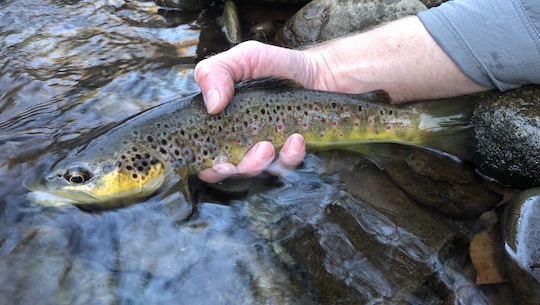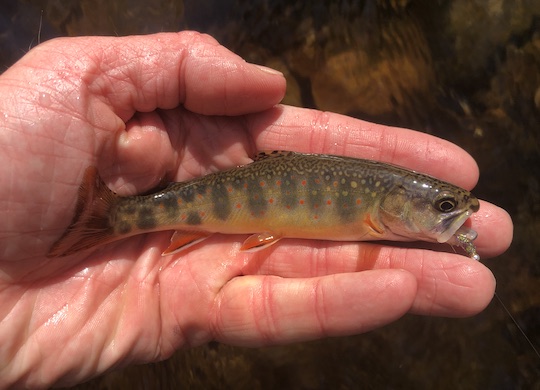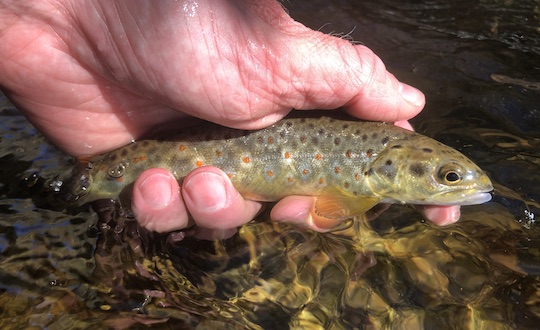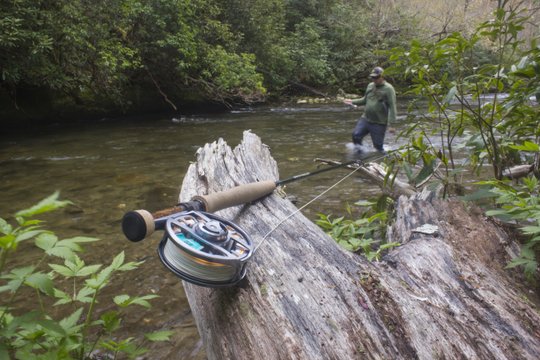If you have followed this blog for any length of time, you probably noticed a period where I blogged about the guided trips I do. However, over time, I realized that I didn't want this blog to become part of my "job," and decided to diligently keep those two things separate. Thus, you have been left with the occasional post about my fishing and anything else that strikes my fancy. Yes, some things are at least motivated by experiences guiding, but for the most part I just use this blog to tell my fishing stories. That was my original motive for starting the blog after all, and what better reason to blog than because I want to remember my fishing trips?
Still, the occasional fishing story from guiding sneaks its way in here. The most recent big guiding event was special enough to merit a place here. However, I want to use it to advocate for something I feel very strongly about: catch and release. When I started guiding, I decided right away that my own personal catch and release ethic would also be part of my business. Trout Zone Anglers is strictly catch and release. End of story. You're more than welcome to write and tell me why I'm so wrong. I've had prospective clients that went elsewhere looking for a guide. In fact, I recommend that they do so if they want to keep fish. You can't pay me enough to take you fishing to harvest a fish.
Part of this is simple economics. If I let every person who I take fishing keep a limit, all of my good fishing holes would be cleaned out in a hurry. I'm not the world's best guide I'm sure, but my clients tend to catch enough fish to put a dent in the population. If everyone out there was keeping their catch, we would be very low on fish in a hurry. I've noticed that fish populations seem a bit decreased anyway right now in the Smokies, so the last thing they need is additional stressors on their numbers.
Another part of this is also simple. I believe that releasing my catch is the best way to pay forward the moment of awe and beauty that happens every time I connect with a trout. Every fish I put back is a fish that some other angler can appreciate and enjoy, and hopefully, will choose to also release so that, eventually, I might get to enjoy the same fish again myself.
This brings me to the last piece. I enjoy catching big trout. I really despise seeing big fish on stringers (I honestly believe it is selfish so go ahead and roast me), but I also hate to see small trout being taken because those are the ones that will become big trout someday one way or another. On rivers that I fish like the Caney Fork and Clinch, there are good numbers of fish right up to the top of the protected length range but very few over. Instead of catching lots of fish between 14 and 19 inches, I personally think it would be even better to catch lots of fish between 14 and 24 inches or larger. A minimum size limit on brown trout of 30 inches would gain my instant support. There are rivers and places that have such regulations, and there are reasons they have a tremendous following.
A few days ago, I was able to enjoy first hand the benefits of catch and release. Up until recently, the largest trout that I had ever had a client land was 25.5" and it was a brown trout on the Clinch River. That fish was caught by my good friend and client, Chuck Traylor (#bigfishchuck) on a #20 barbless midge on 6x tippet. We were in the drift boat when the magic happened, and I'll never forget that massive hen brown trout.
 |
| Angler Chuck Traylor with a 25.5" trophy Clinch River brown trout. ©2019 David Knapp Photography |
The saying goes something along the lines of lightning never strikes twice, but in my case it did. Fast forward in time to just a few days ago, over a year and a half from Chuck's big trout, and you'll find me yet again drifting down the Clinch River.
My client this particular day was Bill Cash, an excellent angler from the northeast who is on a mission to fish all of the 50 Best Tailwaters. If you don't have that book yet, then check it out by the way. The Clinch River was going to be number 25 on his quest. By some stroke of fortune on my end, I got the call to share the river with him. Some anglers don't really need guides, but they enjoy having someone show them the ropes and shorten the learning curve on new water. Right away, I figured out that Bill was one of those anglers. His casting was very good and fish fighting skills were on point. He would need those skills early on this day.
We hadn't been drifting very long when the indicator twitched then briefly dipped. He set the hook, but for some reason it didn't stick. That turned out to be a very good thing. Seriously though, when was the last time you were thankful for missing a fish? Not too often I'm guessing. After the recast, we drifted a very short distance downstream when the indicator went down convincingly. This time, there was some weight on the other end.
Having guided for quite a few years and fished even longer on the Clinch, I was expecting a standard operating model. That would be a rainbow trout somewhere in the 15-18 inch range and probably hot. The fish would likely jump or at least roll on the surface. Initially, things seemed to progress right on schedule. The fish made a hard run from right to left across the front of the boat. I noticed right away that Bill was keeping appropriate side pressure and letting the fish run when it wanted to. Things got interesting, however, when he absolutely could not turn the fish.
When I asked about the fish, he said it was a pretty good fish, probably 18-20 inches. That's a good way to start the day. Then he said something that had me wondering. "It is a brown trout." Okay, so not what I was expecting after all. A brown trout would explain the digging for the bottom and head shakes, however. Eventually, the fish made it close enough to the boat for me to get a glimpse. I was convinced of the brown trout diagnosis and also began to think the fish might be a little larger, maybe in the 22" range.
With 6x tippet to both flies and our largest offering a #18 midge, I advised him to not push the fish too hard. The water was ice cold and well oxygenated from the early morning generation pulse. This fish was going to be fine. At this point, Bill was totally focused and putting on a clinic when it comes to fighting large trout. Low side pressure and pushing the 6x to just short of the breaking point was a recipe for success.
When the fish started a hard upstream run, I realized we would have to pursue. Getting the oars going, we gave chase. This fish eventually took us up and down but apparently it wanted to stay on its home turf and never went too far up or downstream. A couple of times it got dangerously close to some logs, but by some miracle, it stayed out of the structure for us.
The fish came boat side but was staying deep. I contemplated deep netting the fish, something I've done on big brown trout before. When I stuck the big Fishpond boat net in the water near the fish, I realized something important. The fish was at least as long as the 25" opening on my net hoop. A mistake trying to dredge the fish up with the net would almost guarantee losing this monster. We were going to have to get the big trout's head up before making the scoop.
Again, out of an abundance of caution, Bill asked if he needed to put more pressure on the fish. I reassured him that he was fine. Any more pressure and that fish was going to be gone. Finally, the fish began wearing down. Another blistering run back downstream got us closer and closer to landing the beast. Finally, the big trout began coming to the surface. Bill was putting enough pressure on the fish that I was nervous. Still, we had to get this fish up somehow. When it rolled near the boat, I was ready or so I thought. What I hadn't counted on was how big this fish was. Even larger than it had looked at depth, this fish was a true fish of a lifetime. The net barely contained the big hen brown trout. I quickly handed the net off to Bill and asked him to keep the trout's head submerged while I got the boat situated. Then we ascertained the situation and got the necessary pictures.
When we put the trout on the tape, it stretched to 27.25", a true monster and the largest I've had the good fortune to see on my boat so far. The pictures were done quickly, and within about 10 seconds we had the fish back in the cold water. I had jumped out of the boat as soon as the anchor was down and wasn't taking any chances on the health of this fish. We kept her cradled upright and revived her carefully. Finally, with several powerful thrusts of her tail, she sped off back to the depths.
Then we just sat there and soaked up the moment. Both of us realized that we had reached the pinnacle of the day early. This big brown trout would almost certainly be the largest fish of the day. Once we started fishing again, we began drifting though the same area where the big brown trout had been caught. On our second pass through this area, I noticed a dark shadow shoot under the boat and settle into a large depression not far away. Upon closer inspection, I realized it was the big brown trout that we had released well across the river and upstream. She was back almost exactly where we had caught her already which told me she was going to be fine.
The rest of the day featured good fishing although it was largely anticlimactic. We caught plenty of rainbow trout up to about 19 inches with the smallest being around 13 inches. No more browns showed up though. Interestingly, a lot of brown trout were stocked early this year. I saw them leaving the river by the stringer load. I don't know what in the world people are going to do with a bunch of 7 inch trout. Personally, I would rather see them stay in the river. We had just witnessed what the Clinch River is capable of producing if the fish are just left in the river to grow. Most of our tailwaters could be full of 16-24 inch trout if people would just release their catch. I for one wish that more anglers would choose this strategy with the long term goal of catching more and larger trout.
The moment this point was driven home was when I texted Chuck a picture of the big fish later in the day. Not too long after, he responded by mentioning that he thought it was the same trout he had caught a year and a half ago. If so, the fish had grown by 1.75 inches. That is pretty good for such a large brown trout. When they are younger, they can grow much faster. These old big fish grown much heavier but the length doesn't come as quickly.
When I got home, I checked up on what Chuck had told me. Sure enough, by comparing the spotting on both fish, I realized this was the exact same trout that Chuck had caught before. If he hadn't of released his catch a year and a half ago, then Bill and I wouldn't have had this amazing experience. Thankfully, Bill also released this magnificent fish. I just hope that any other anglers who happen across this fish will do the same thing. Maybe, just maybe, in another couple of years we'll catch her again, and she'll be 30 inches the next time.
 |
| Angler Bill Cash with a 27.25" trophy brown trout on the Clinch River. ©2021 David Knapp Photography |










































